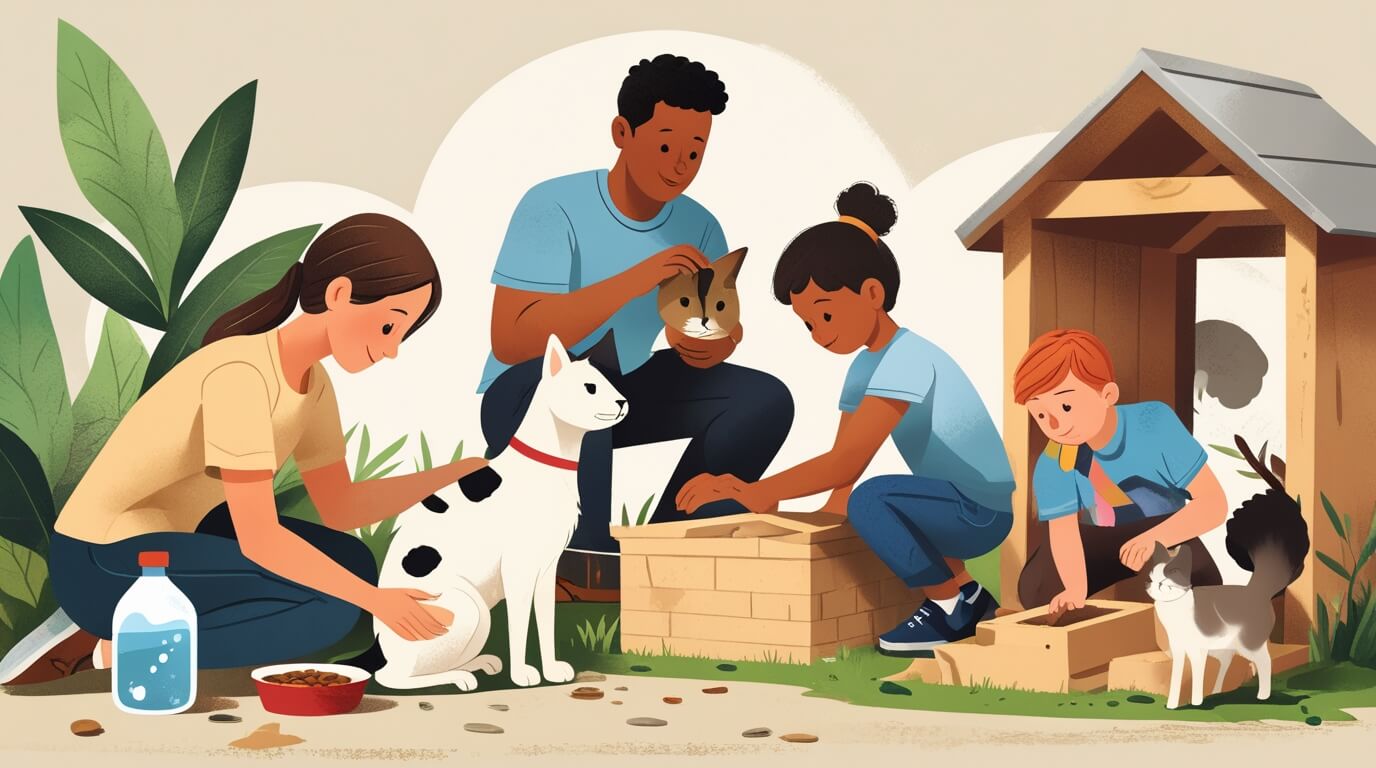Stray animals are a frequent, often heartbreaking, sight in many neighborhoods around the world. From abandoned pets to feral cats and street dogs, these animals navigate daily challenges—hunger, injury, weather extremes, disease, and sometimes abuse. But the good news is: you can help.
Even small, consistent actions can make a lifesaving difference. This comprehensive guide outlines practical ways to support, protect, and advocate for stray animals in your area.
1. Provide Basic Care and First Aid
Strays are often malnourished, dehydrated, and vulnerable to illness or injury.
What You Can Do:
- Food & Water Stations:
- Place clean bowls of water and dry food in quiet, shaded areas.
- Avoid dairy or spicy leftovers—stick to plain rice, boiled chicken, or store-bought pet food.
- Refill water regularly, especially in hot weather.
- First Aid Tips:
- If an animal is injured, bleeding, or limping, approach cautiously.
- Use gloves and avoid direct handling to prevent bites or scratches.
- Keep a basic pet first-aid kit at home (saline solution, antiseptic spray, bandages).
- For serious injuries, call a local veterinarian or animal rescue immediately.
- Winter/Summer Care:
- In cold climates, place warm bedding in a sheltered area.
- In summer, provide shade and ensure fresh water is always available.
Pro Tip: Collaborate with neighbors to create a "care network" where food and water stations are maintained in rotation.
2. Support Trap-Neuter-Return (TNR) Programs
TNR is one of the most effective long-term solutions to the stray animal population crisis.
How It Works:
- Trap: Animals are humanely caught using special cages.
- Neuter/Spay: They are surgically sterilized by veterinarians.
- Return: The animals are returned to their original territory.
Benefits of TNR:
- Prevents overpopulation and the birth of more strays.
- Reduces territorial aggression and mating behaviors.
- Lowers the spread of diseases through vaccination.
- Establishes stable, non-breeding colonies that deter new strays.
Tip: Use resources from groups like Alley Cat Allies or contact local vets to learn how you can safely and legally participate in or sponsor TNR efforts.
3. Work with Animal Shelters and Rescue Groups
Shelters and NGOs are often overwhelmed with the number of animals they care for. You can provide crucial support.
How You Can Help:
- Volunteer Your Time:
- Walk dogs, clean enclosures, or help at adoption drives.
- Offer your skills—graphic design, accounting, photography, or writing—for online adoption posts or fundraisers.
- Donate Supplies or Funds:
- Shelters need blankets, toys, collars, food, leashes, litter, and cleaning products.
- Even small monetary donations help cover vet bills, surgeries, and rescue transport.
- Foster or Adopt:
- Fostering gives an animal temporary care while they await adoption.
- Adoption provides a forever home and directly reduces the number of animals on the street.
Helpful Resource: Petfinder.com lists shelters and adoptable pets in your region.
4. Create Safe Spaces in Your Neighborhood
When a community works together to support strays, everyone benefits.
Ideas to Build Safe Zones:
- DIY Animal Shelters:
- Use wooden crates, plastic containers, or old furniture.
- Insulate with straw (not blankets, which can freeze when wet).
- Ensure they are raised off the ground and protected from rain or direct sun.
- Designated Feeding Stations:
- Avoid littering—keep the area clean to prevent complaints.
- Use consistent feeding times and portions to avoid attracting pests.
- Add signage to educate passersby about the initiative.
- Neighborhood Committees:
- Form a local animal welfare group to assign tasks like feeding, TNR tracking, vet visits, and community outreach.
Pro Tip: Add reflective stickers or solar lights near shelters so cars can spot them at night.
5. Educate and Advocate for Animal Welfare
Awareness is the first step toward widespread, sustainable change.
Ways to Spread Awareness:
- School & College Talks:
- Organize animal welfare workshops or guest speakers from NGOs.
- Include information on pet care, strays, and animal laws.
- Community Events:
- Host adoption days, awareness booths, or fundraising bake sales.
- Share rescue success stories to inspire others.
Fact: According to the WHO, over 200 million stray dogs live worldwide. Your voice can influence local policy and public behavior.
6. Contact Local Authorities When Needed
While you may want to help every animal, some cases require intervention from professionals.
When to Call for Help:
- Injured, sick, or aggressive animals that cannot be approached safely.
- Animals trapped in drains, vehicles, or abandoned buildings.
- Suspected cases of abuse, poisoning, or neglect.
Partner with Local Government:
- Advocate for municipal sterilization programs.
- Push for better funding for animal shelters.
- Support policies that criminalize animal cruelty and promote adoption.
Resource Tip: Some regions offer 24/7 animal rescue hotlines—save these numbers in your phone.
Additional Ways You Can Contribute
- Report Lost/Found Animals on online platforms like Facebook groups, Nextdoor, or local rescue websites.
- Microchip Your Pets to prevent them from becoming strays.
- Organize Fundraisers for emergency surgeries or medical expenses.
- Learn Animal Behavior Basics to handle fearful or injured animals more safely.
Conclusion: Be the Change
- Helping stray animals is a blend of compassion, consistency, and community collaboration. It's about more than temporary relief—it's about long-term transformation. When individuals like you take action, you don't just save lives—you lead by example, showing that empathy and responsibility go hand in hand.
- Whether you're feeding a hungry pup, organizing a TNR drive, or sharing an adoption post—you are making a difference.
- Because every animal deserves love, safety, and a second chance.
